CLCV131: Archaic Period Vocab
0.0(0)
Card Sorting
1/122
Earn XP
Description and Tags
Study Analytics
Name | Mastery | Learn | Test | Matching | Spaced |
|---|
No study sessions yet.
123 Terms
1
New cards
Submycenaean
1125-1050 BC; less sophisticated; less heavily decorated; less skilled potters; haphazard decoration
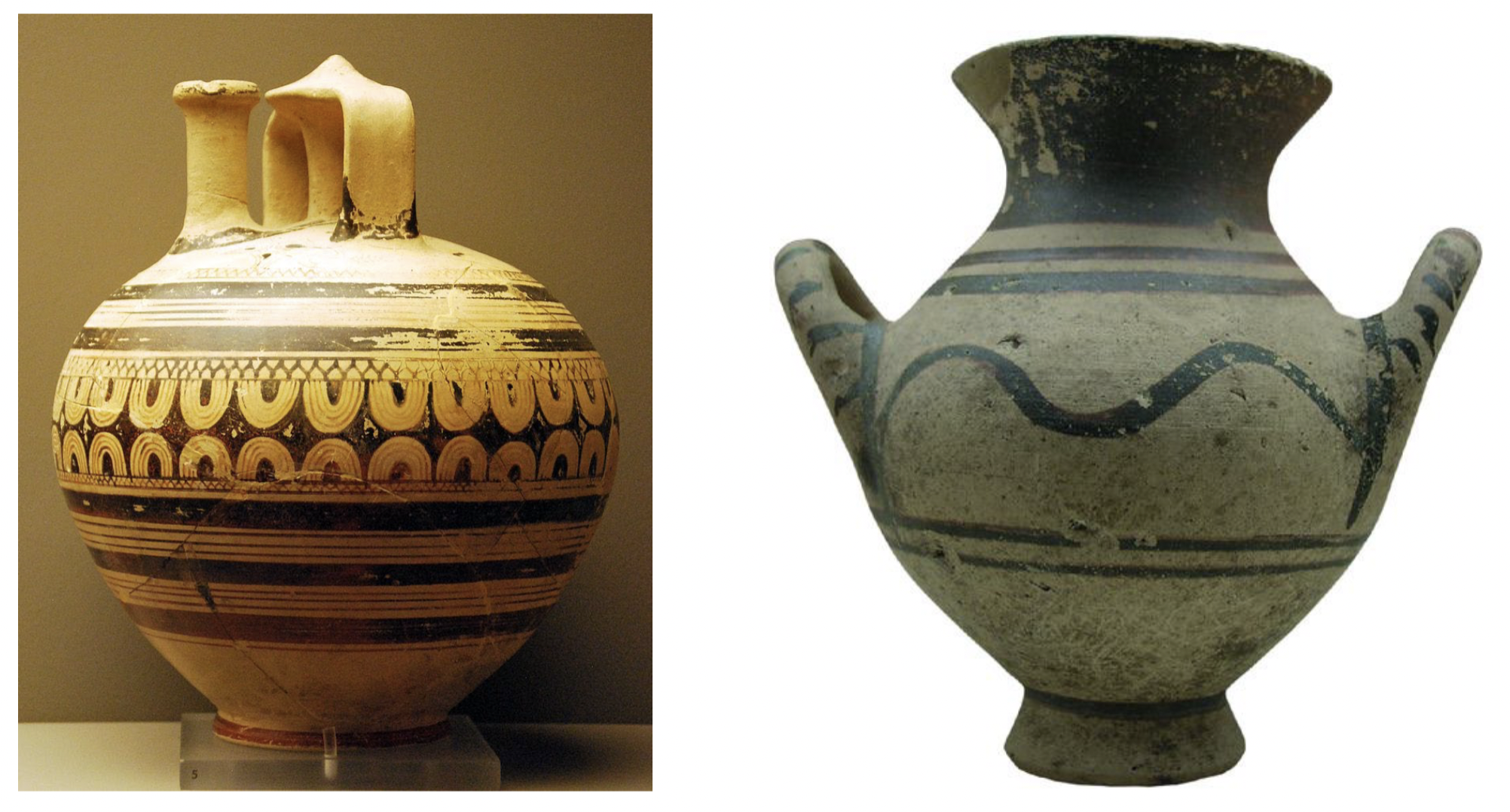
2
New cards
Protogeometric
1050-900 BC; circles/curves painted w multiple brushes; usually don’t see animal/human figures
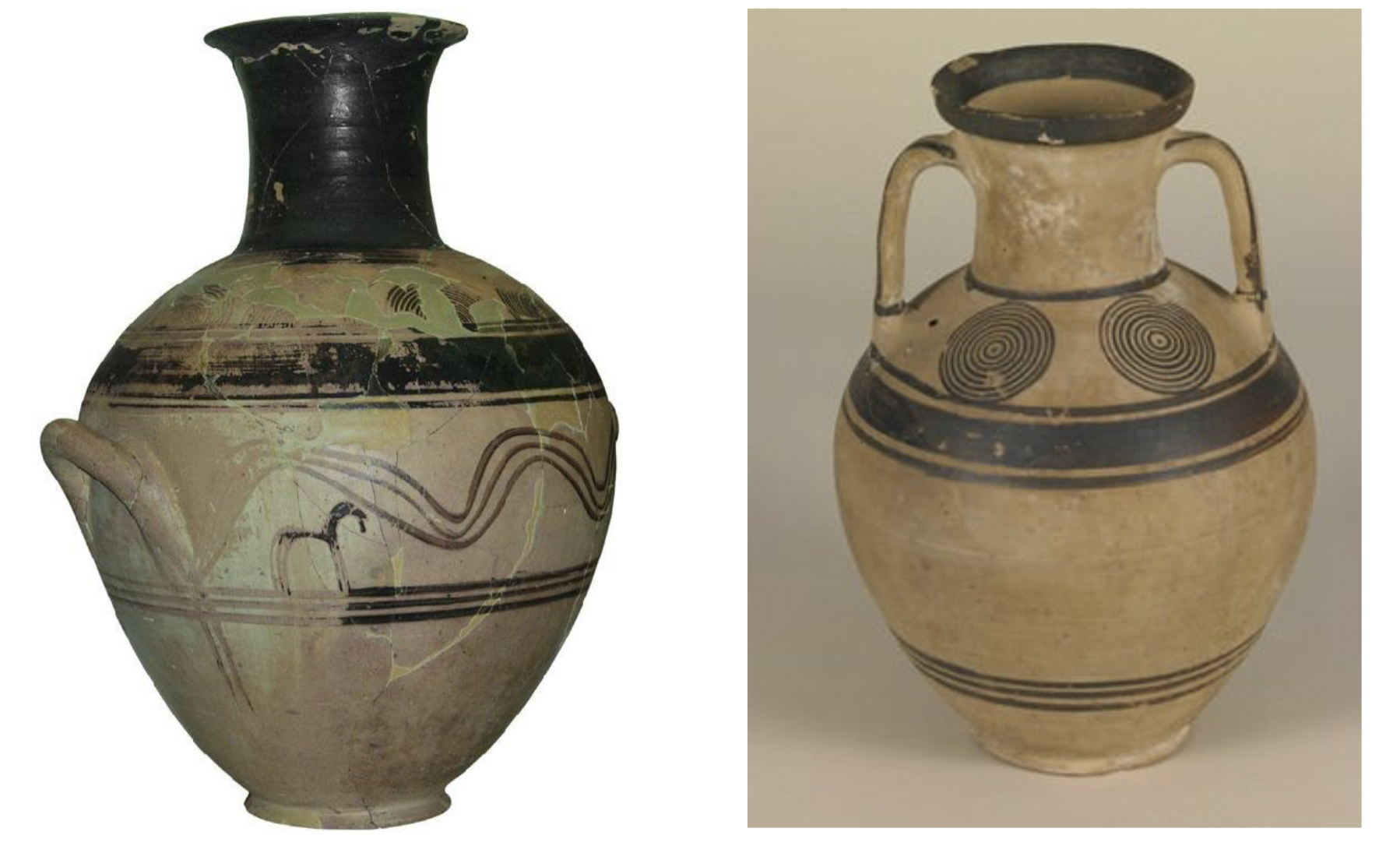
3
New cards
Early Geometric
900-850 BC; geometric wow; more sophisticated geometry; decoration takes up more of pot
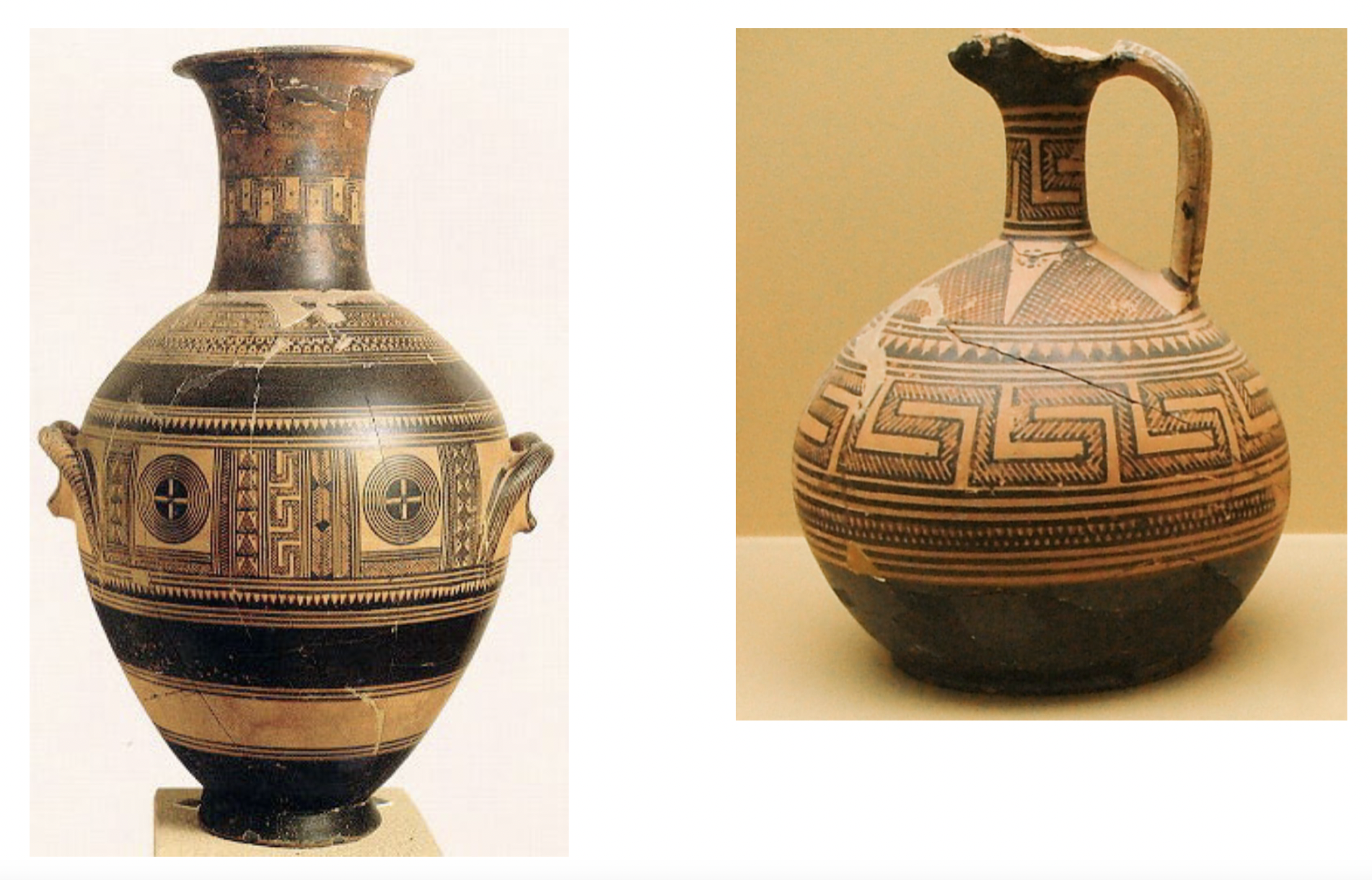
4
New cards
Middle Geometric
850-750 BC; human and animal figures (not main decor)
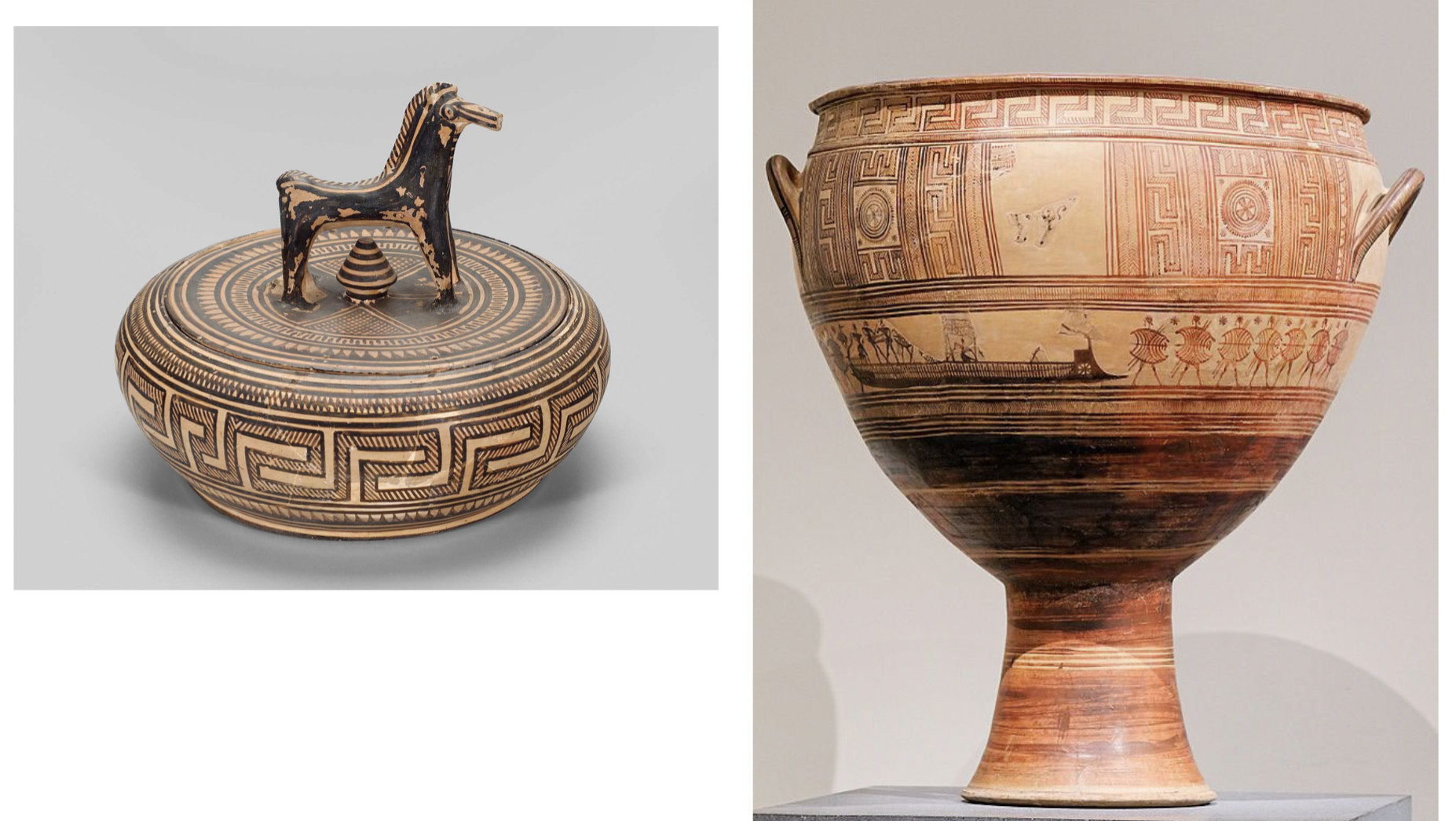
5
New cards
Heroön
a shrine dedicated to an ancient Greek or Roman hero and used for the commemoration or cult worship of the hero; often erected over his or her supposed tomb
6
New cards
Apse
a domed or vaulted recess or projection on a building especially the east end of a church
7
New cards
Al-Mina
an ancient trading post on the Mediterranean coast of northern Syria, in the estuary of the Orontes River, near Samandağ, in Hatay Province of Turkey
8
New cards
Emporion
trading center
9
New cards
Hekatompedon
"hundred feet" in Greek
10
New cards
Architectural Order
Doric, Ionic, Corinthian, Tuscan, and Composite. There are many separate elements that make up a complete column and entablature.
11
New cards
Xoanon
statue of a god protected by a temple; the oldest of which, called xoana,
were made of wood and thus quite fragile
(pl = Xoana)
were made of wood and thus quite fragile
(pl = Xoana)
12
New cards
Electrum
alloy of gold and silver, used to produce the first coins
13
New cards
Phoenicians
developed a written language – an alphabet, not a syllabary
14
New cards
Temenos
boundary in which worship activities took place
15
New cards
Altar
a table or flat-topped block used as the focus for a religious ritual, especially for making sacrifices or offerings to a deity
16
New cards
Naos/Hieron
dwelling of a god; inner part of a temple; shrine

17
New cards
Pronaos
a vestibule at the front of a classical temple, enclosed by a portico and projecting sidewalls

18
New cards
Opisthodomos
the rear room of an ancient Greek temple or the inner shrine
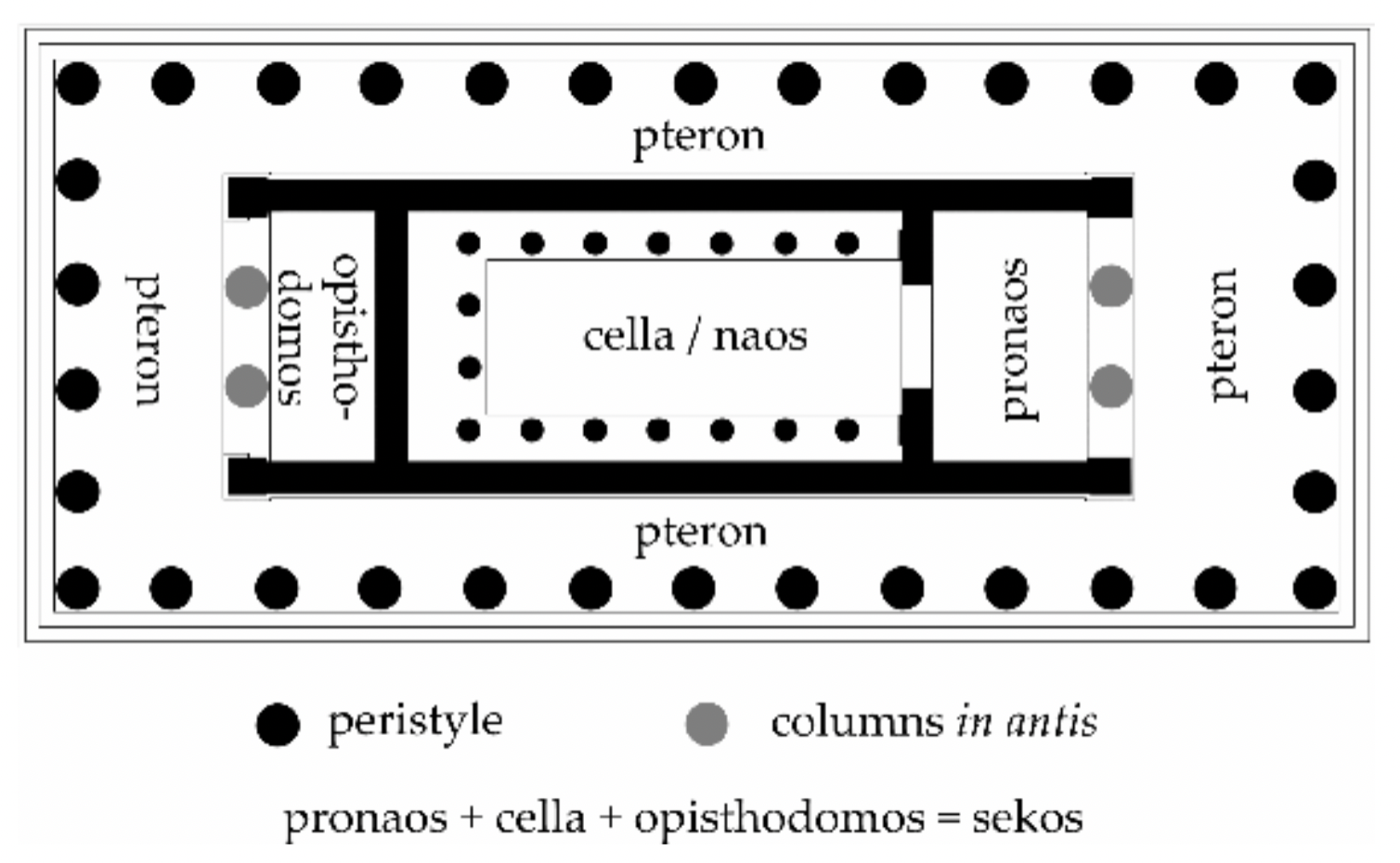
19
New cards
Pteron
a side (as of a temple) in classical architecture
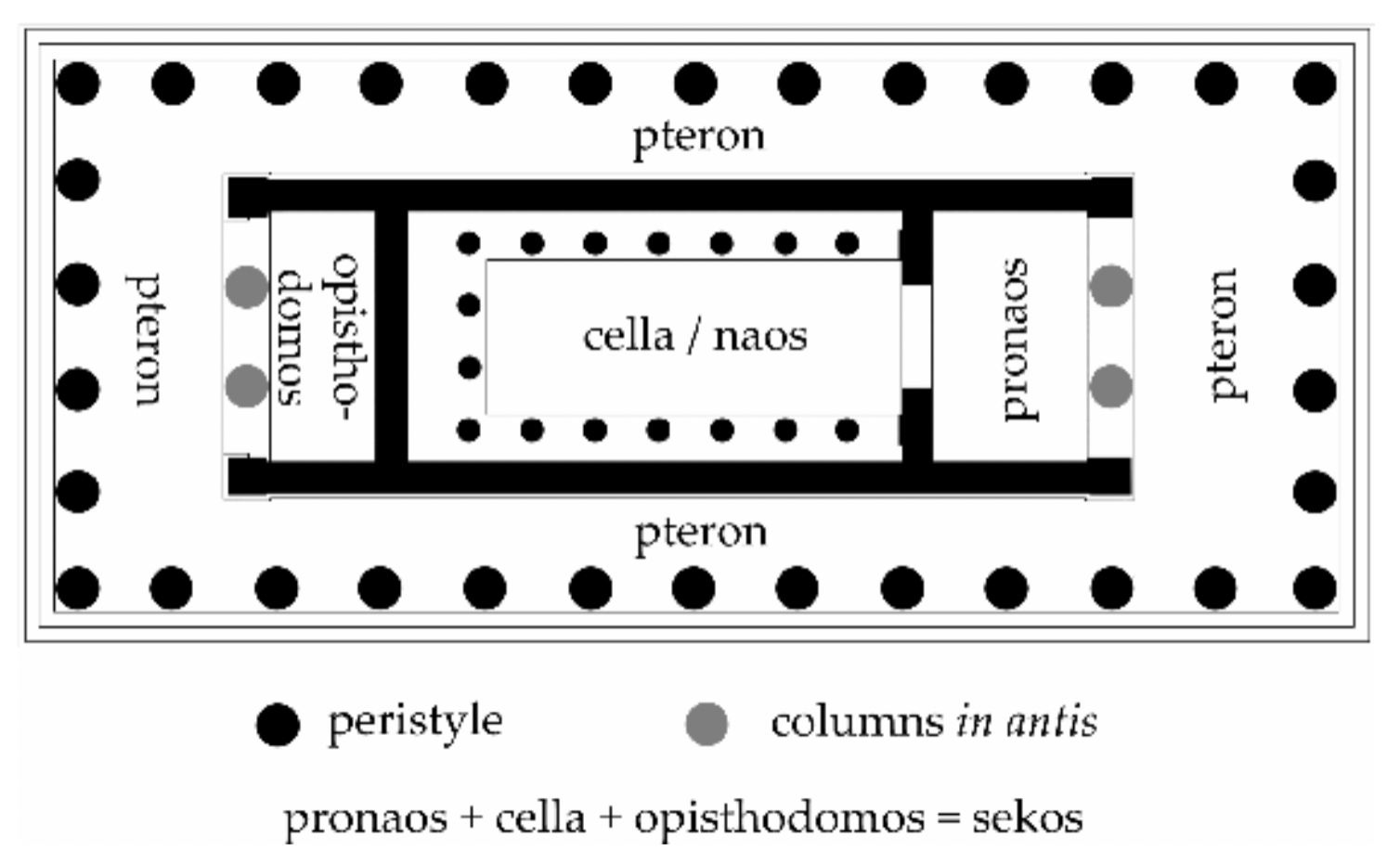
20
New cards
Sekos
a sacred enclosure or inner sanctuary
21
New cards
Stoa
a freestanding colonnade or covered walkway; also, a long open building, its roof supported by one or more rows of columns parallel to the rear wall; porch(?)
22
New cards
Sphyrelata
a type of archaic Greek bronze votive statues of considerable size
23
New cards
Peribolos
wall around space (peri = all the way around)
24
New cards
Propylaia
fancy/monumental gate
25
New cards
Perirrhanterion
water basin for ritual cleaning
26
New cards
Agalma
(dedications) high value gifts; means “a thing for looking at”
27
New cards
Votive Offering
(dedications) little gifts to give to the god as reminders; do something nice for me in return
28
New cards
Votive Deposit
(dedications) buried extra votive offerings
29
New cards
Kernos
bowl with multiple little wells for the first things people produced that year (e.g: wool, cherries)
30
New cards
Asylia
(cf: modern asylum)
31
New cards
Miasma
“bad vibes”; need to be ritually cleaned
32
New cards
Acroterion
little sculptures on the roof
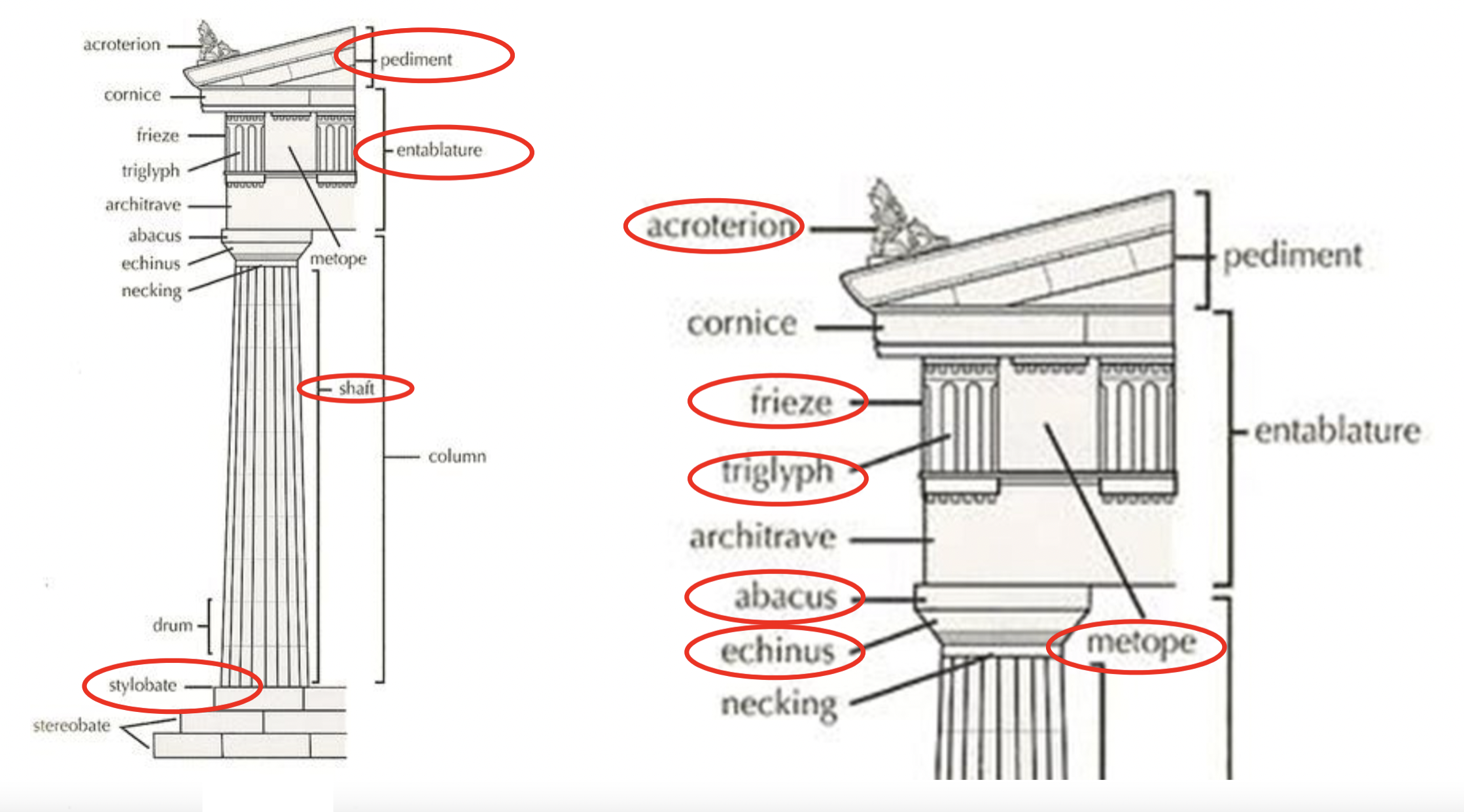
33
New cards
Pediment
the triangular place under the roof of a temple
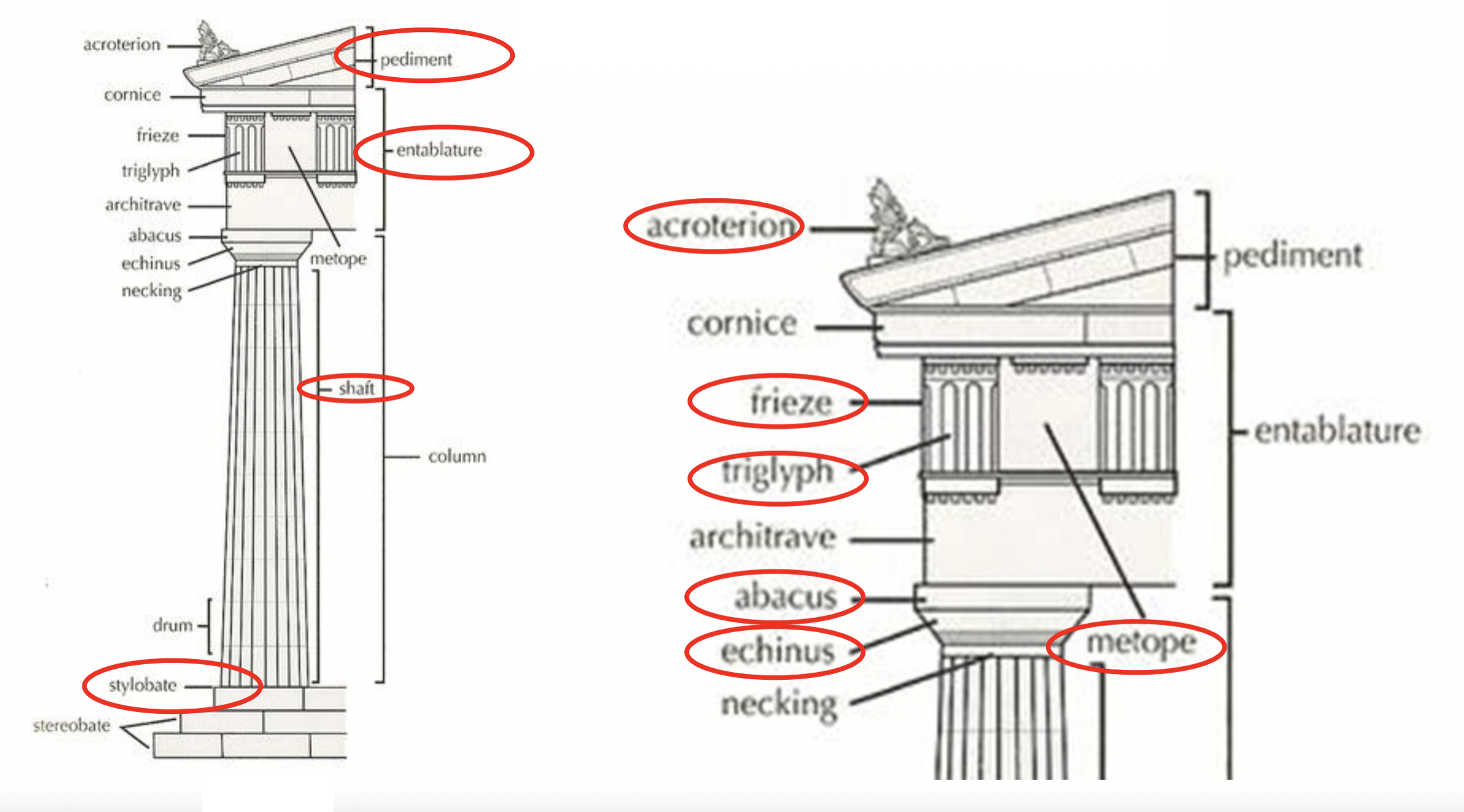
34
New cards
Entablature
EVERYTHING ABOVE THE COLUMNS; a horizontal, continuous lintel on a classical building supported by columns or a wall, comprising the architrave, frieze, and cornice (NOT THE TRIANGLE PART?)

35
New cards
Doric frieze
uses triglyph and metope, in the entablature
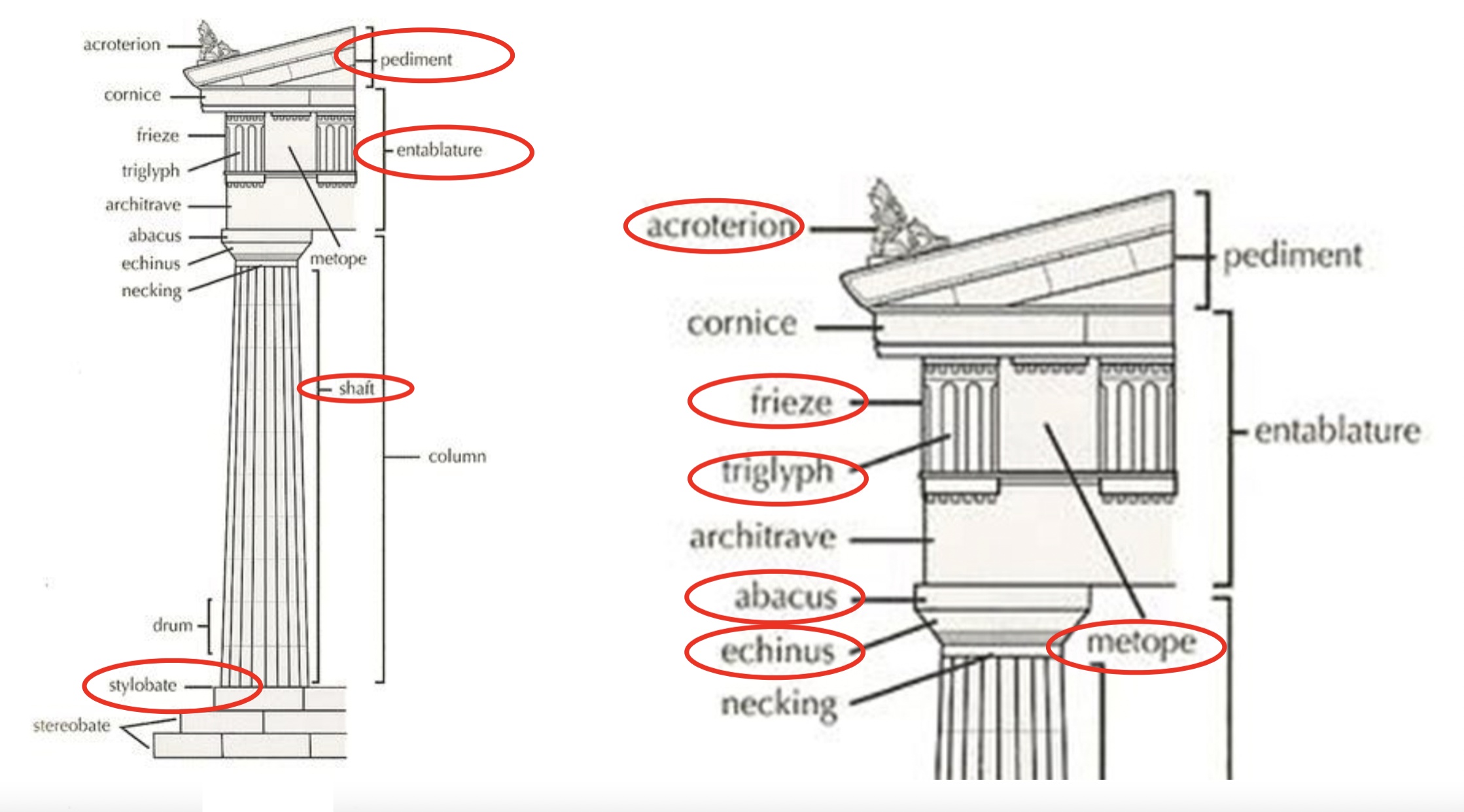
36
New cards
Triglyph
(doric frieze) vertically channeled tablets
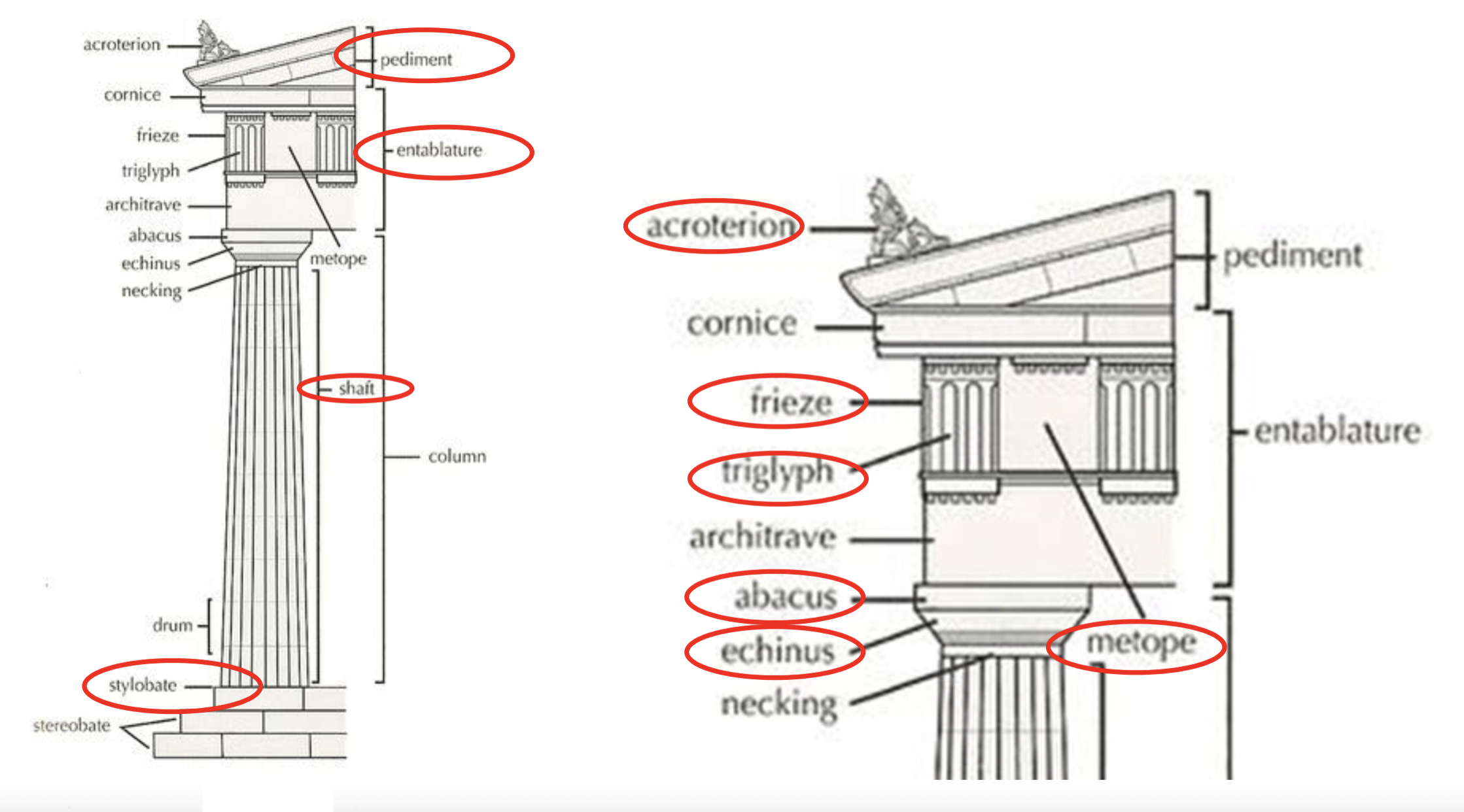
37
New cards
Metope
(doric frieze) a rectangular architectural element that fills the space between two triglyphs
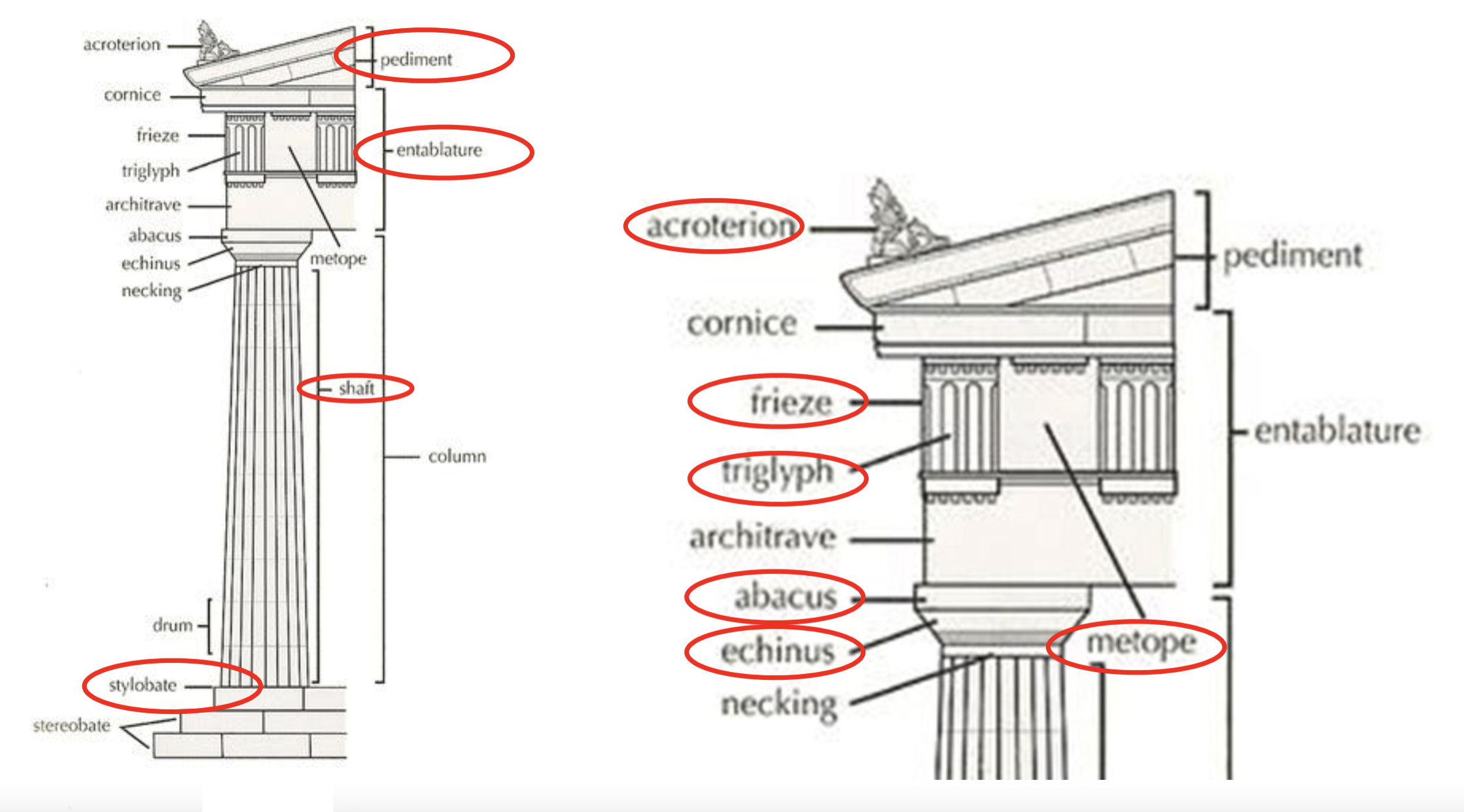
38
New cards
Doric column
base of column sits right on the top step of the temple (styleobate), with nothing in between (no fr base ig, column just starts); top of column is very simple

39
New cards
Abacus
(doric column) square bit between the entablature and the capital
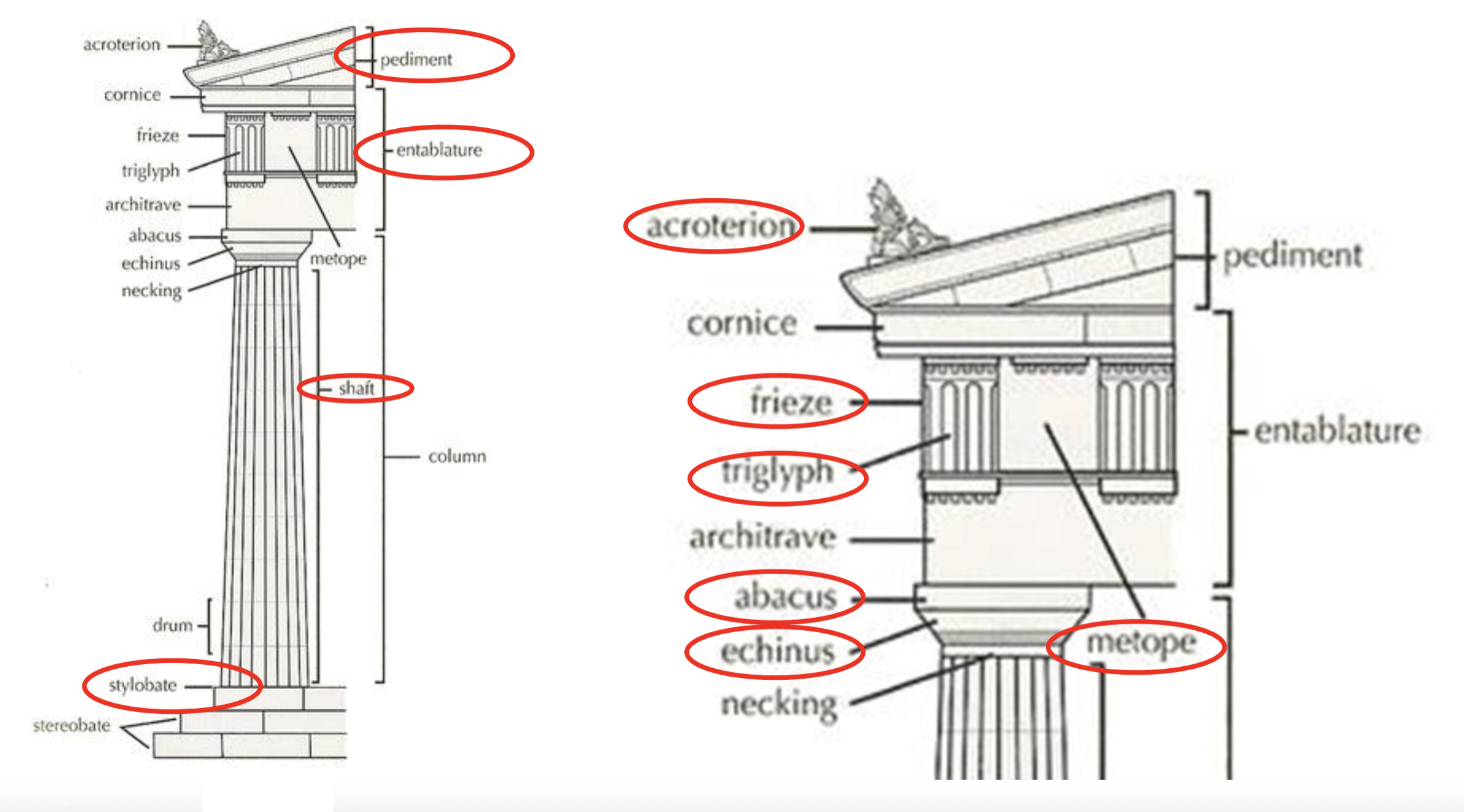
40
New cards
Echinus
(doric column) round bit below abacus
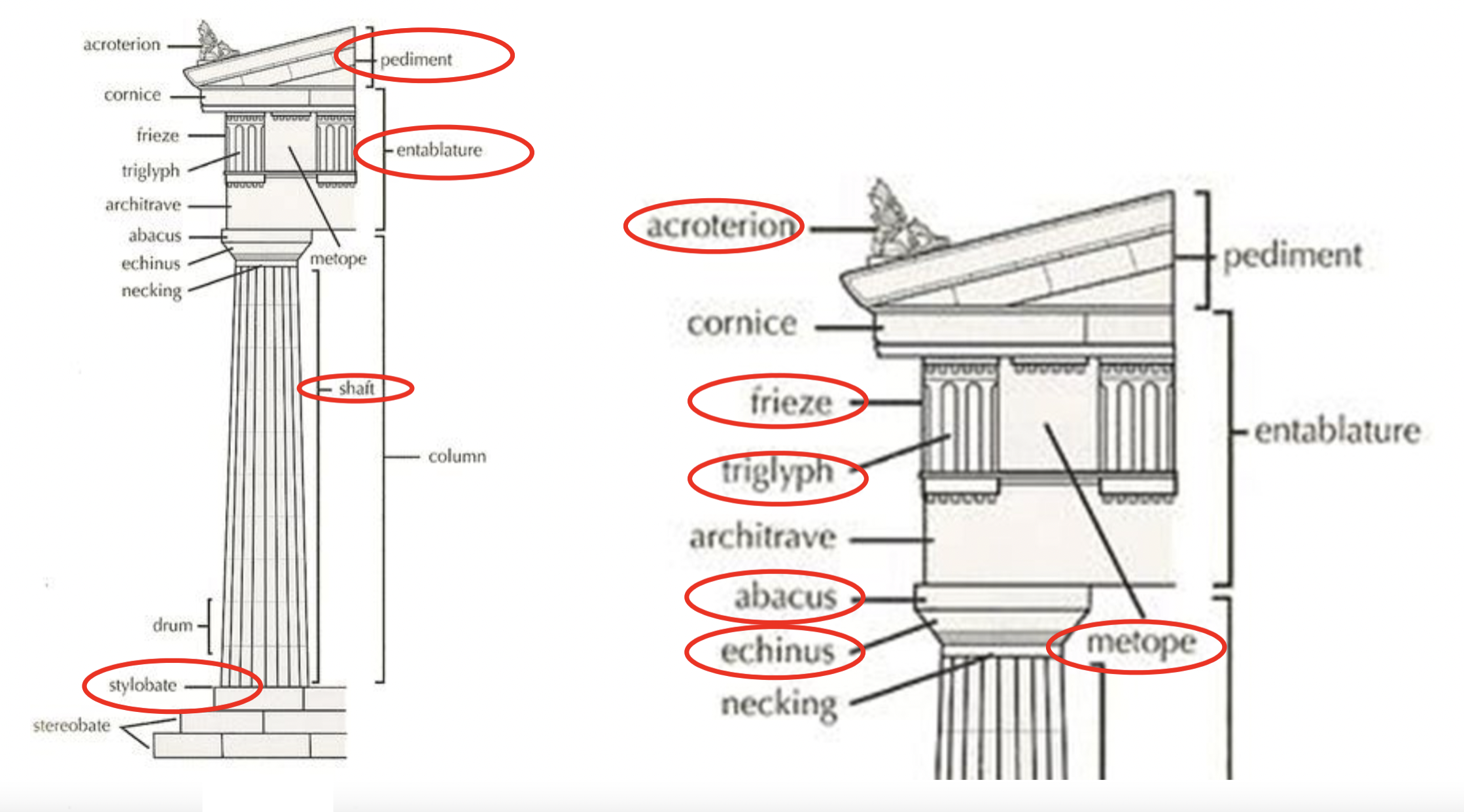
41
New cards
Flutes
(doric column) grooves running down a column
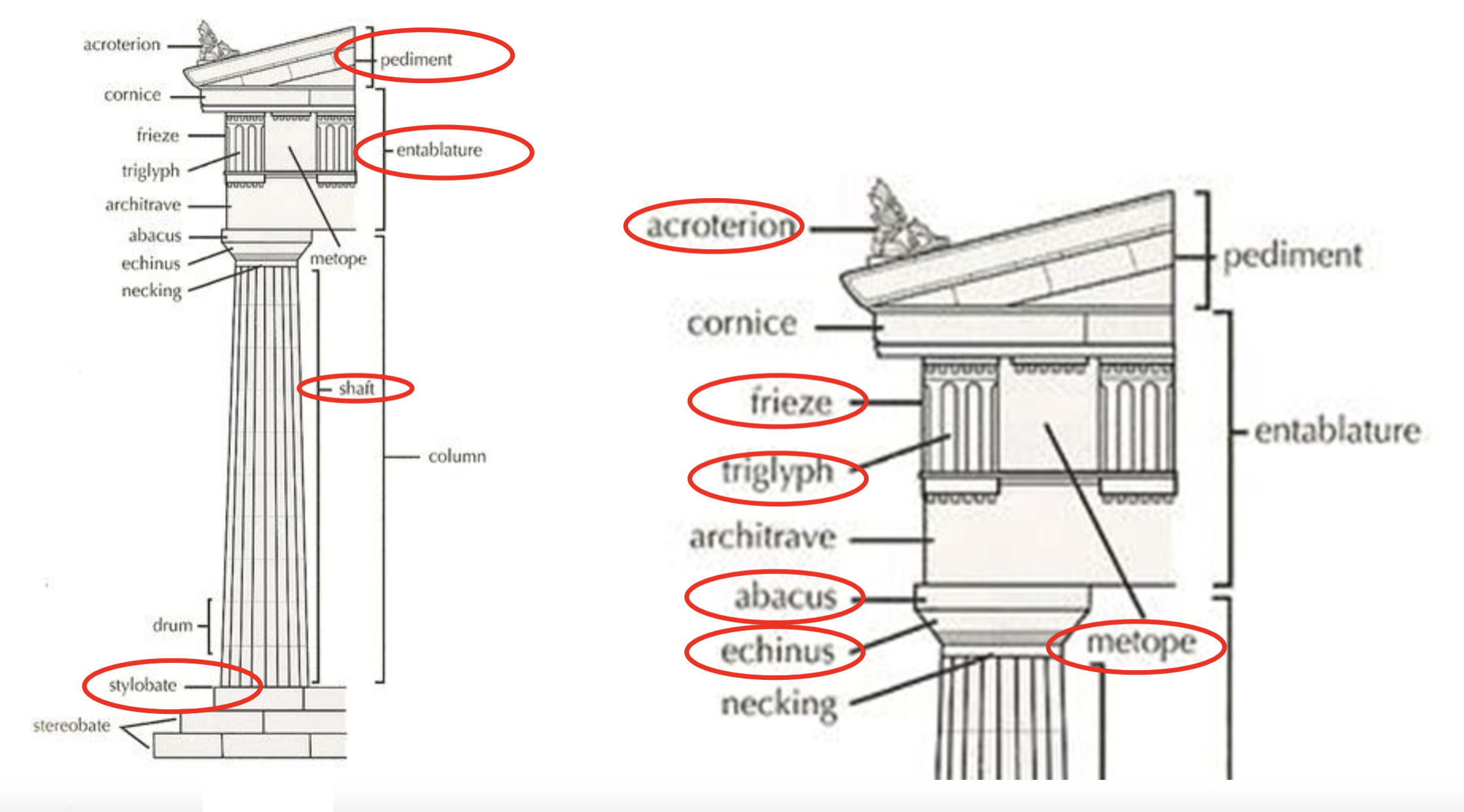
42
New cards
Column Shaft
(doric column) tall bit of column
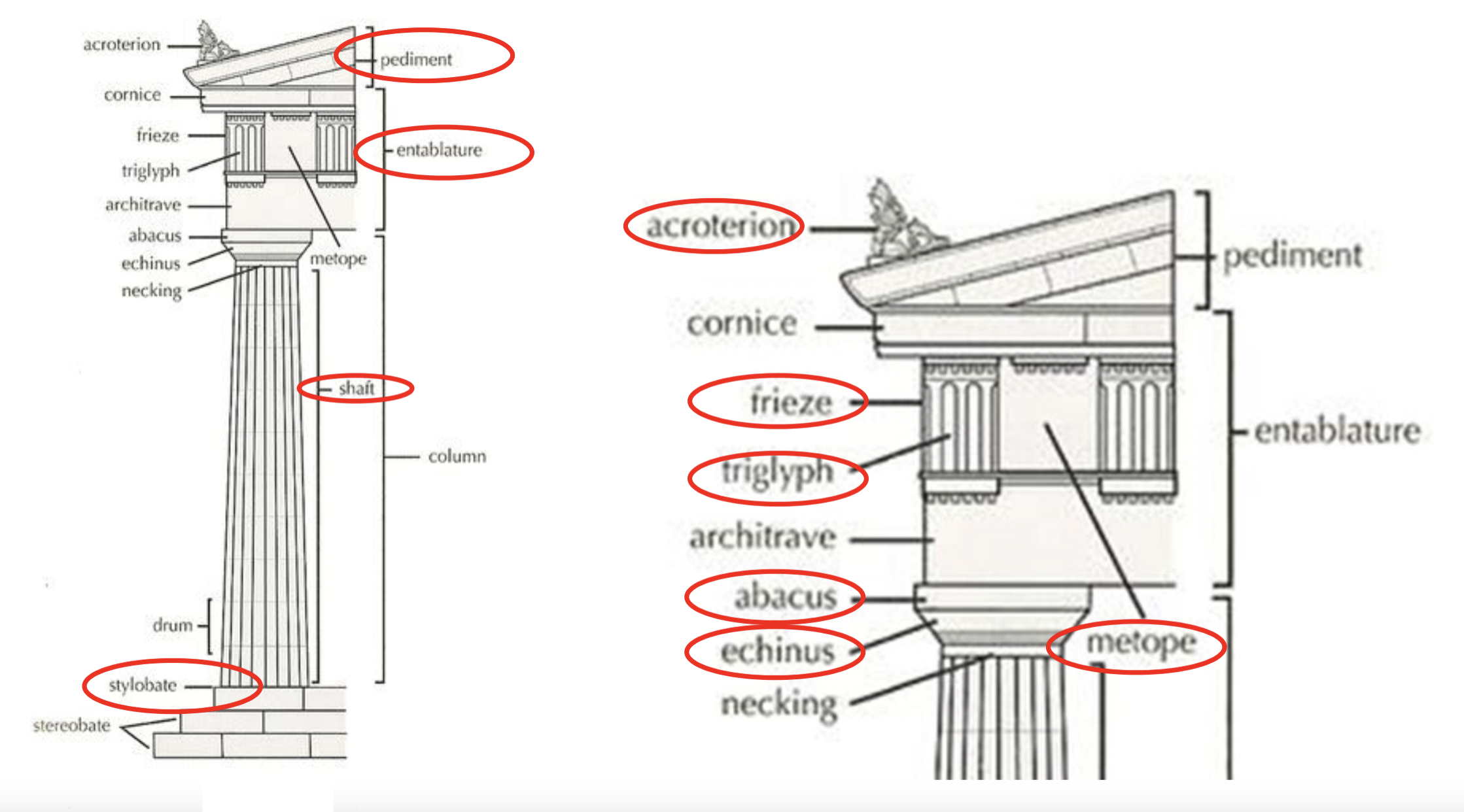
43
New cards
Peristyle
holds the end of the roof up??; a row of columns surrounding a space within a building such as a court or internal garden or edging a veranda or porch
44
New cards
Pteron
walkway between outside(?) and temple
45
New cards
Columns in antis
columns between the ends of walls
46
New cards
Pronaos
“thing before the naos”; porch
47
New cards
Naos/Cella
main room
48
New cards
Adyton
fourth little room connected to the naos but no to the opisthodomos; "no go area"; for fancy votive offerings
49
New cards
Prostyle
features a row of columns on the front
50
New cards
Amphiprostyle
small temple with a row of columns in the front and back, NOT all the way around
51
New cards
Peripteral
features columns all the way around
52
New cards
Dipteral
features two sets of columns all the way around (double peristyle)
53
New cards
Hexastyle
6 columns across the front
54
New cards
Oktastyle
8 columns across the front
55
New cards
Entasis
swelling of the columns to make a building look lighter (less heavy, not less dark)
56
New cards
Visual Refinements
small adjustments to a building to influence the perception of the structure
57
New cards
Echinus
wider than abacus in Doric style
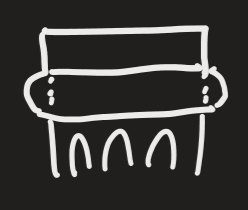
58
New cards
The Doric Corner Conflict
Have to end the corner of a doric temple on a column and want the triglyph centered over a column, but want to keep the triglyphs and metopes at regular sizes
59
New cards
Ionic Frieze
• Column with a base (as opposed to baseless doric columns)
• Column capital with volutes (curly pieces) / more décor in general
• Ionic Frieze - often sculpted with low reliefs (NO triglyphs or metopes)
• Column capital with volutes (curly pieces) / more décor in general
• Ionic Frieze - often sculpted with low reliefs (NO triglyphs or metopes)
60
New cards
Volute
curly pieces at the top of columns
61
New cards
Column Base
at the bottom of Ionic style columns??
62
New cards
Polychromy
painted with many colors
63
New cards
Daidalic Style
Crete and the Cycladic islands; mostly women; weirdly high up eyes; cinched waists; grid like hair
64
New cards
Kore / Korai
statue of young women/maiden; influenced by ANE
65
New cards
Kouros / Kouroi
statue of young man; influenced by Egypt; rarely clothed
66
New cards
Canon of Proportions
grid guideline for sketching before carving/painting; from Egypt but adopted by the Greeks
67
New cards
Archaic smile
technical issue; sign of status (geleontes = aristocrats/"the smiling ones")
68
New cards
Chiton
wide width of fabric draped to make a dress
69
New cards
Himation
mantle, wrap, cape
70
New cards
Peplos
narrower, heavier than Chiton; worn over Chiton; like wearing a jumper
71
New cards
Fibulae
clothespins
72
New cards
Kosmos
adornment, order, government, universe (women's beauty standards)
73
New cards
Kaos
chaos, disorder
74
New cards
Kerameikos
industrial part of Athens with pottery workshops and cemeteries
75
New cards
Prosthesis
lying in state of a body?
76
New cards
Protocorinthian style (pottery)
small objects, color + patterns, incision, influenced by ANE
77
New cards
Cycladic relief style (pottery)
decoration extrudes from the pot
78
New cards
Protoattic style (pottery)
decorated with scenes from mythology??; decorative fillers; foreshortening
79
New cards
Attic Black Figure
silhouette elaborated with red/white paint and engraved details
80
New cards
Slip
clay + water; used to decorate pots
81
New cards
Sinter
process by which slip turns to an impermeable, glassy surface
82
New cards
Kiln
furnace used to fire pottery
83
New cards
Amphora
a storage/transport vessel; associated with the burial of women
84
New cards
Pithos
very large storage jar
85
New cards
Krater
large open vessel for mixing wine; associated with the burial of men
86
New cards
Skyphos / Kantharos
deep drinking cup
87
New cards
Kylix
shallow drinking bowl
88
New cards
Olpe / Oinochoe
pouring jug
89
New cards
Pyxis
small jar with a lid for storage
90
New cards
Lekythos
pouring jug with a long neck for oil
91
New cards
Hoplite
Focused on combat between formations of non-elite citizen soldiers, as opposed to individual combat (e.g: in Trojan War epics)
92
New cards
Achilles
a mythical Greek hero of the Iliad; a foremost Greek warrior at the siege of Troy
93
New cards
Homeric Hero
men of superhuman strength, courage, or ability, favoured by the gods (e.g: Achilles)
94
New cards
Wedding of Peleus and Thetis
Aphrodite bribed Peleus that he would have a beautiful wife; Peleus marries Thetis, they birth Achilles
95
New cards
Connoisseurship
they have a deep love and extensive knowledge of a subject that's considered to be a matter of taste
96
New cards
Etruscans
member of an ancient people of Etruria, Italy; liked to collect Greek vases
97
New cards
Tumulus
an ancient burial mound; a barrow
98
New cards
Lydos
Attic vase painter in the black-figure style; signed "The Lydian"
99
New cards
Bilingual Vase Painting
vase with Side A (more important) & Side B depicting 2 different things; appear in the early development of the Attic red figure technique
100
New cards
The Pioneer Group
painters Euphronios, Euthymides, Smikros, Hypsias, the 'Dikaios Painter' and Phintias